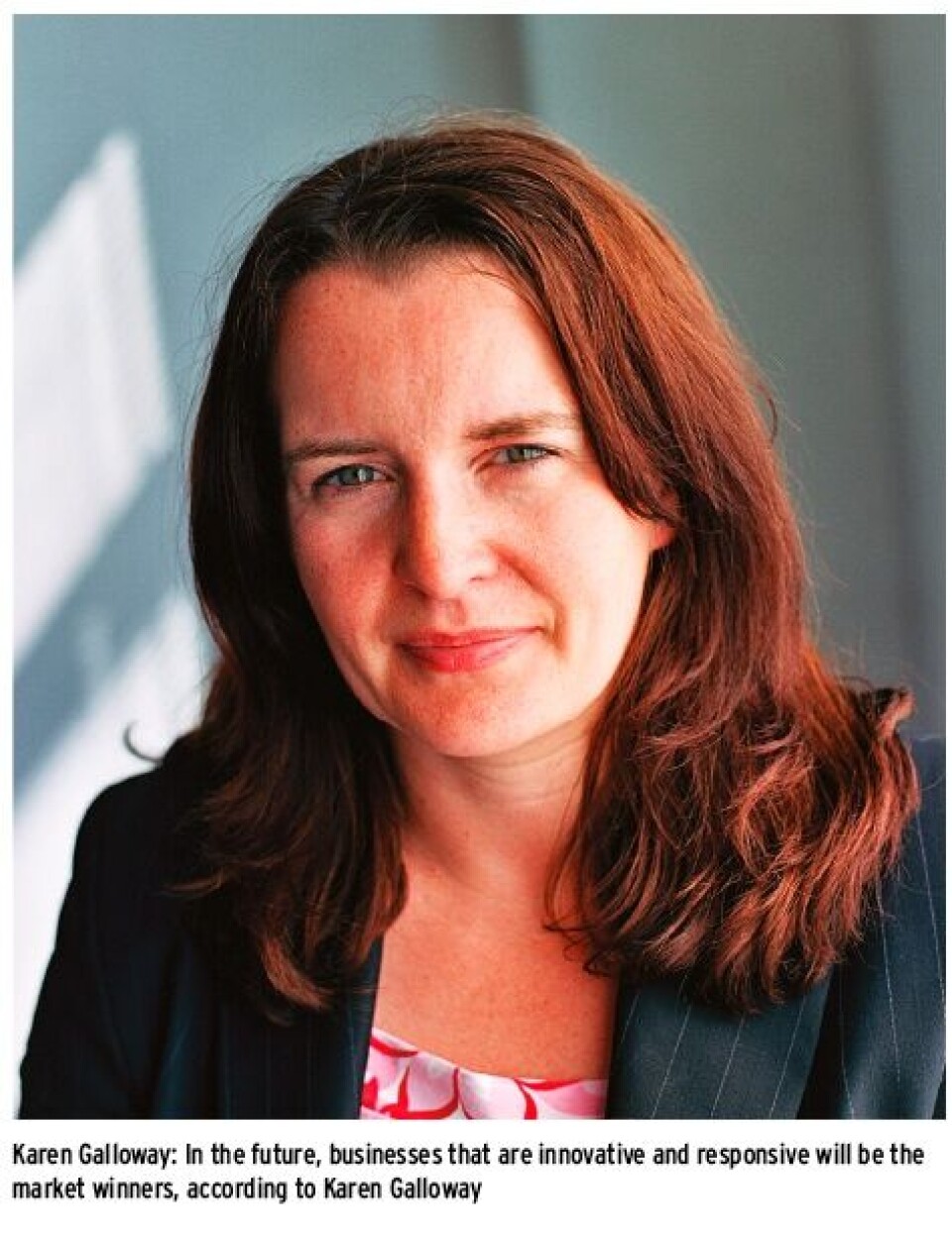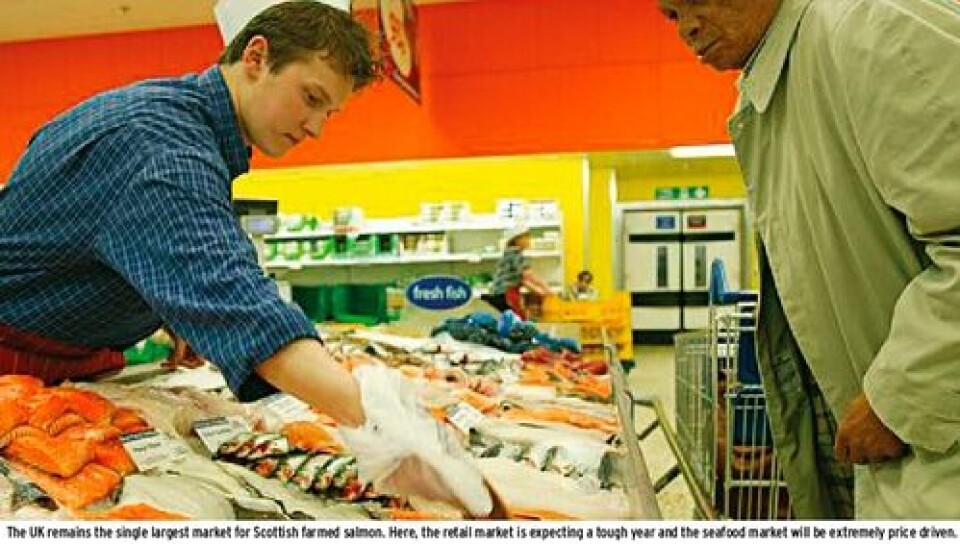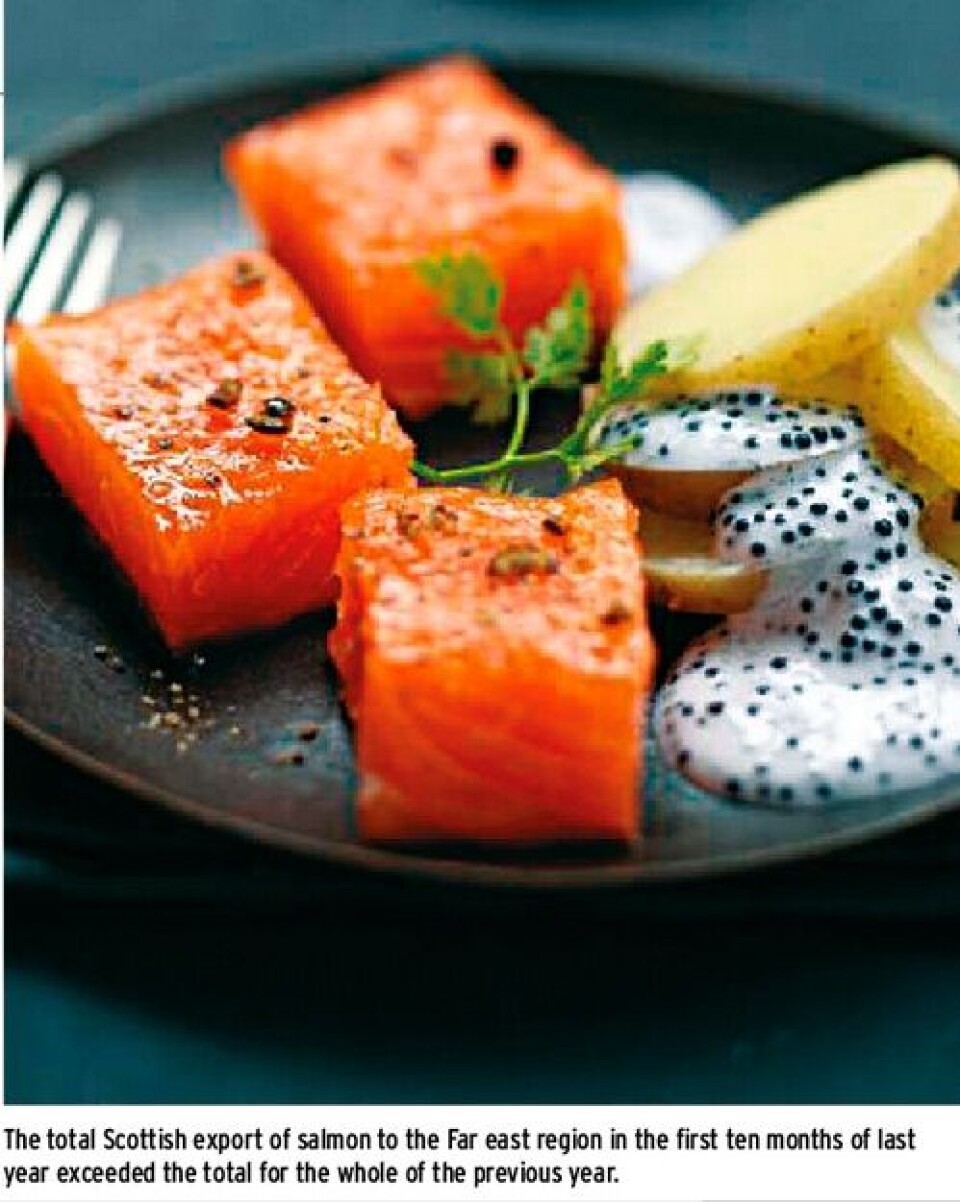No letting up in 2013

SCOTLAND: 2013 is set to be another tough financial year in the UK with a strong focus on price in the retail market. However, the export position for the Scottish salmon farming industry remains good. A further growth in export to new markets in Asia and Europe is also expected. 2012 saw significantly lower prices compared with 2011, which has helped boost salmon demand in most markets, despite falling consumer confidence in Europe. But many have predicted that 2013 could be another tough year. However, with a projected reduction in farmed salmon on the market this year, prices may start moving up already in the first quarter some claim. Gorjan Nikolik, senior associate at Rabobank International, even predicted that once the prices start to increase, they will remain high and may never slump again: “In 2014, once prices start to increase, we can expect to see a really high increase. Given this slump is so deep, it will be a long and high cycle. “It could be the last period with low salmon prices. Something major would need to happen for this to change.” In Scotland, complete figures for sales and export of farmed salmon in 2012 are not yet available for all markets, but figures up until October last year reveal that the export position for the Scottish salmon farming industry remained strong. New figures released for the Scottish salmon export to the Far East in 2012 show sales at record levels following the third consecutive year of increases.
The UK remains the single largest market for Scottish farmed salmon. Here, the retail market is expecting a tough year and the seafood market will be extremely price driven. Industry spokesman David Sandison says he still expects reasonable prices for Scottish farmed salmon in 2013. “It won’t be exciting, but profitable,” he points out.

Growing in new markets In recent years, Scottish salmon producers have taken advantage of the growing demand for salmon across the world.
The high export levels in recent years have helped the salmon industry to achieve two successive record years of capital investment, with £44.4 million and £47.6 million invested in 2010 and 2011. The vast majority of the £92 million capital investments have been made in the Highlands and Islands. The total investment over the last five years is £205.5 million. “People still eat salmon. There has been a 26 per cent growth of salmon consumption in Europe. There’s 60 per cent growth in Russia, 85 per cent in Latin-America and 35 per cent growth in China,” Nikolik of Rabobank told Norsk Fiskeoppdrett in October 2012.
In Scotland, recently released data from HM Revenue & Customs reveals that 8,675 tonnes of salmon were exported to the fast growing emerging markets in the Far East in the first ten months of 2012, which is greater than the whole of the previous year (2011). Exports to the world’s second largest economy have now increased by 1,172 per cent in the three years since 2010. The value of the exports (fresh, frozen and smoked products) has increased from £28 million between January and October 2011 to more than £37 million for the same period in 2012. The Far East markets include China, Thailand, Malaysia, Singapore, Vietnam, Japan, Taiwan, South Korea, Philippines and Hong Kong. China is now the main market in the Far East, just 20 months after an agreement was reached to permit direct exports of seafood from Scotland to the People’s Republic. Scott Landsburgh, chief executive of the Scottish Salmon Producers’ Organisation (SSPO), says there is great scope further market share expansion: “The total exports to the region in the first ten months of last year exceeded the total for the whole of the previous year. “Sales have increased more than twelve-fold in three years and our market share still only represents less than one per cent of the total current opportunity in the Far East. “In the vast region even niches of niches are huge, so the rewards for finding the right opportunities can be phenomenal. “With a rapid growth of middle classes looking for premium and healthy products, there remains plenty of scope for further market share expansion in this rapidly growing market.” Further export growth to the region is to be targeted later this year, as representatives from the salmon and langoustine sectors, SSPO, Scottish Quality Salmon, Scottish Development International and Scotland Food & Drink are to attend HOFEX 2013, the Far East’s leading retail and food service event in Hong Kong (7 – 10 May 2013). 31,000 visitors from 85 countries are expected to attend. US dropping back The full export market figures for Scottish salmon in 2012 are not yet available. Export data from Seafish up to October 2012 show that the US was still the biggest export market for Scottish salmon last year (weight 29,020,768, value £146,132,845,), followed by France (weight £17,591,077, value 68,255,188) and Ireland (weight29,680, 316, value £6340,304). Next are China, Poland, Belgium and Germany. David Sandison, general manager of Shetland Aquaculture, says there has also been an increase in exports to the Far East from Shetland in this period and points out that it is positive with growth in a market where the producers get a reasonable premium. “It is a boost from a commercial point of view,” he adds. It looks very likely that the US will remain the biggest export market for Scottish salmon in 2012, but there has been some decline in shipments to this market due to Chile’s comeback.
“The US has dropped back a bit, as the price was repressed in 2012 with Chile back on the scene,” Sandison says. He claims prices have been more stable in Europe and reveals that Scottish producers have been expanding trade in Eastern Europe. However, Scotland did not see the same volume growth in 2012 as producer nations such as Norway. “Overall, there has not been a big growth in production levels. The Scottish production has stayed flat, with an expected small increase for 2013,” Sandison says. He underlines that overproduction is not good if there is no clear view as to where the additional produce will go.

He expects reasonable prices in 2013 that will keep the producers in profit. Although he points out that it is not the price, but keeping the production price down, which is the biggest challenge currently - for example with regards to feed ingredients. “But the systems we use are well advanced and we have good stable contracts, so I think we will do reasonably well in 2013. There are real challenges in our industry and it is not only good news, but we manage as well as we can. We have done well to deal with these challenges and there are good market opportunities. I am positive. “In Shetland, one of the successes of recent years has been a large-scale production of smoked salmon products for the UK market. This is a very attractive product, which I can see growing further in the future,” he points out. Growth for smoked salmon Sandison prediction with regards to smoked salmon is likely to be accurate. Research by retail analysts Kantar Worldpanel has found that sales of smoked salmon have been increasing for the last four years and peak in the four weeks of December. The total annual smoked salmon market in 2011 was worth £117 million in the UK, increasing from £90 million in 2008. Producers expect sales have grown again in 2012. “The value of sales is rising, with the total amount people spend on smoked salmon increasing the last four festive periods and the four-week Christmas period accounts for over 19 per cent of smoked salmon sales throughout the year,” says Mark Thomson, business unit director at Kantar Worldpanel. However, market commentator Martin Jaffa of Callender McDowell points out that if if similar levels could be achieved throughout the year, smoked salmon sales would go through the roof. “The problem is that smoked salmon is still perceived as being for a special occasion rather than an every-day option.”
Price led market According to Seafish Industry Authorities, UK shoppers remained focused on price and promotions in 2012 and attempted to manage the purchase volume. However, many were prepared to pay more for quality ingredients or quality. A Seafish report for the first half of last year does however show that the provenance trend has not accelerated – patriotic packaging and campaigns have resonated well, but have not fuelled interest in British or local sourcing any further. Going into 2013, the general feel is that it will be a tough year for the retail industry, says market analyst Karen Galloway from Seafish: “In 2012 there was the Jubilee and the Olympics, which created a lot of noise in the market. Retailers were able to capitalise on that. In 2013 there are no events. Last year there were lots of activities that gave it a boost. In 2013 the economy in the UK is challenging,” Galloway explains She thinks this will create an even greater emphasis on price. “My general feel is that the focus on price will be ever greater. Promotions such as ‘buy one get one free’ are not evident in the market place now. “Consumers are concerned about their food bill, and there is a focus on which retailer can give them the best basket price. This is going to be more apparent,” she claims
So what does this mean for the salmon industry? Margin delivery is a key, according to Galloway: “The seafood industry will find next year challenging. The industry is risk averse of new products -we will not see many new products in the market in 2013. For salmon, the ability to be part of the “3 for £10” or “2 for £6” deals will be important. They need to be in the game and they need to continue hitting the price point. There needs to be margin delivery. Suppliers need to know what to do to hit it,” Galloway underlines and adds that there is no innovation in the market. “It is different than 3-5 years ago. Salmon rely on Christmas, and I think it has been a ‘mixed bag’ this year. Some producers and retailers done have done well, and some have struggles.
“We do not yet have the full year statistics for 2012, but I think Christmas have been challenging. It has been tough for retailers. It has been focus on price, price price…” she points out.
However, she also confirms that the export position for salmon remain good. “Salmon export has had another good year. It’s driven a lot by currency and structural changes. The industry looks at where the price is best and this swings in roundabouts.”
In the future, she thinks it is the businesses that are innovative and responsive that will be the market winners. “With a tough trading year ahead and things happening in the market, businesses need to be responsive. When we start coming out of the recession, they need to bring new products to market quickly,” Galloway stresses.






















































